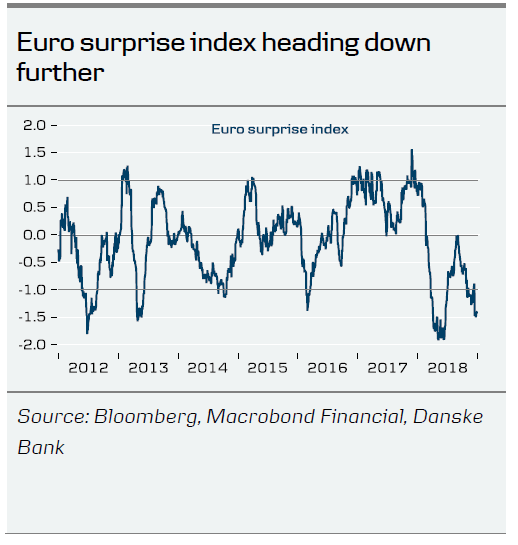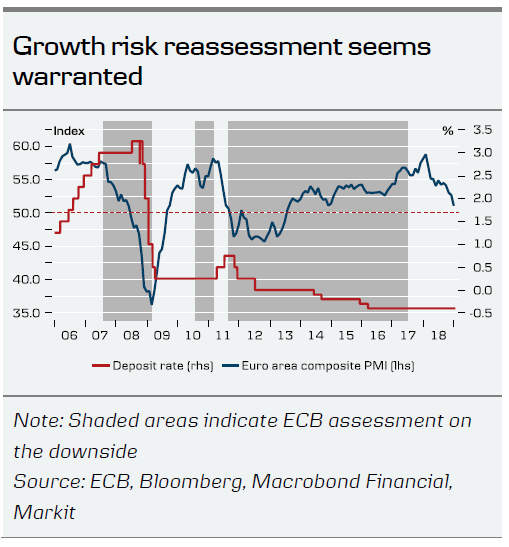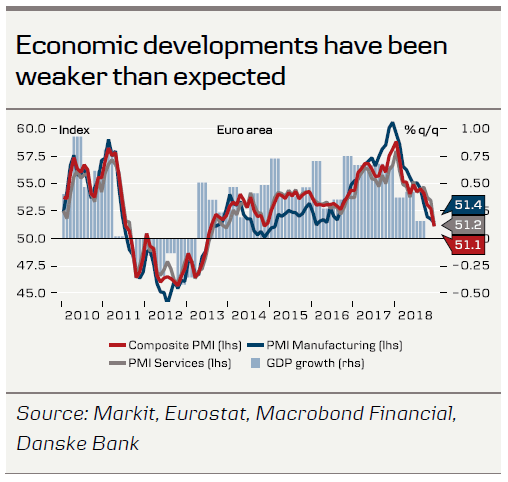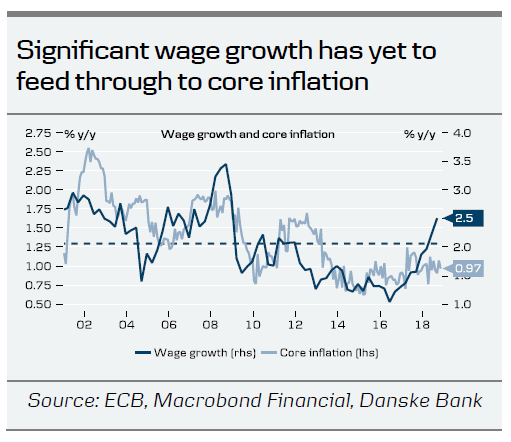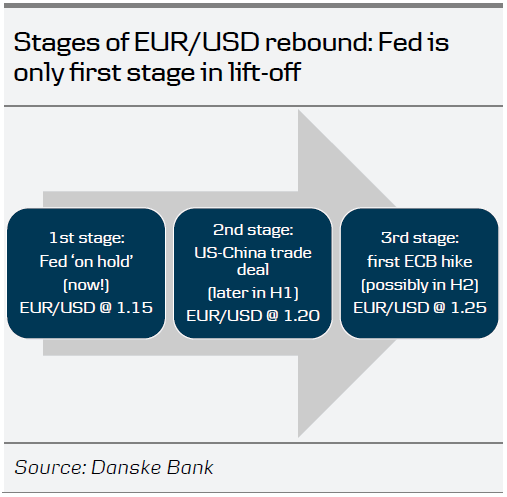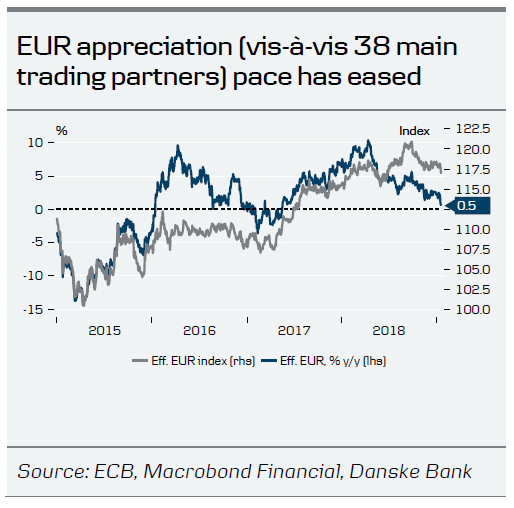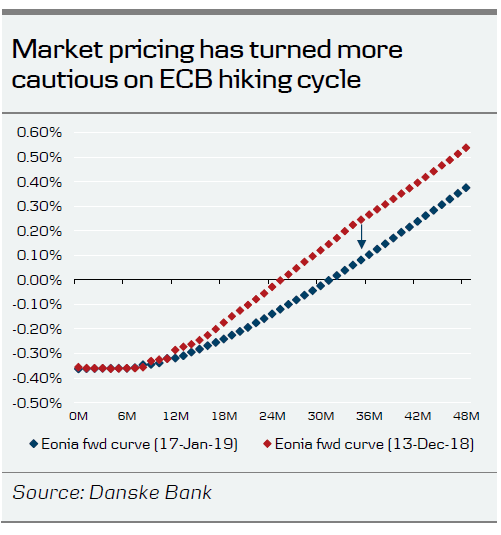- Most interesting to us at next week’s meeting will be the growth risk assessment and more hints on liquidity operations. We expect growth risk to be on the downside and no formal announcement of liquidity operations.
- We expect Mario Draghi to strike a precautionary tone in order not to move markets. Given the current market pricing, we do not expect the precautionary tone to lead to a significant dovish market reaction to the meeting.
Downside growth risk assessment expected…
After the ECB decided to end net asset purchases in December 2018, new policy signals are not warranted at next week’s meeting in our view. Instead, the hotly debated growth risk assessment is set to take centre stage. At the previous meeting, the ECB coined the growth risk assessment as broadly balanced but moving to the downside. Since then, we have seen a string of disappointing data, which is also visible in the surprise indicator close to the lows reached around the sovereign debt crisis (see Since the previous meeting below).
One could argue that the downside risk assessment has been long overdue looking at both soft and hard indicators. The shaded areas in the chart below indicate when the ECB has historically assessed the growth risks to be on the downside. Previously, when we have observed a similar correction in PMIs/the growth outlook as in recent months, the ECB has also changed its growth risk assessment, which could therefore have been warranted earlier. However, we believe that the broadly balanced risk assessment at the December meeting was needed for the ECB to end net purchases.
Furthermore, we note several governing council members have argued for a continuation of the narrative, while others point to the softer data warranting a change to the overall risk assessment. The previous time the ECB changed its risk assessment was in June 2017 (from downside to balanced).
…but we stick to our December 2019 rate hike
Even though we expect a downside risk assessment next week, we do not change our ECB rate hike call from December 2019. The softer data at the start of the year was already expected, also as activity in China remained weak. Our main argument for expecting a rate hike by the end of the year is due to our expectation that wage growth will translate into underlying inflation towards summer (see also Euro Area Research – Is the Phillips curve finally coming alive in 2019?, 18 December 2018.)
We acknowledge that our expectations for a December rate hike is not a balanced risk. We see a 10% chance of an earlier than December rate hike, a 60% chance of December 2019 hike and a 30% chance of a later-than-expected rate hike. Given the increased risk of the ECB hiking rates only after December 2019 on the back of a more severe slowdown than first expected, we reflected on the possible line of policy responses (assuming the ECB does not get to hike rates) in Guns (and not bazookas) dominate ECB’s crisis arsenal, 9 January.
Liquidity operation – tasked committees for now
We do not expect a formal announcement of a new round of liquidity rounds at the meeting next week but only in March. At the December meeting Draghi said that ‘At some point in time, our committees will start to work on that’. We expect the committees to be tasked formally to examine the liquidity situation next week. Previously, when the ECB made large changes to its monetary policy stance, it has used task committees.
The effectiveness of the operation will depend on the modalities and the devil will be in the detail. With the recent comments from ECB President Mario Draghi at the December press conference, we are leaning towards similar terms as with the 2011/12 VLTRO operations (see ECB Research – Guns (and not bazookas) dominate ECB’s crisis arsenal, 9 January).
Since the previous meeting
Since the latest Governing Council meeting in December, data has again mostly surprised on the downside, both on the growth and inflation front, while the continued strong labour market situation remains one of the few rays of light for the ECB.
Economic activity
Activity data has been weak across the board and December PMIs still painted a lacklustre picture of the eurozone economy (the January PMI will be released only on the same day as the ECB meeting). In particular, service sector activity took a marked hit from the yellow vest protests in France, while the manufacturing weakness in Germany continues to persist as car sector bottlenecks abate only slowly. It is likely the growth momentum in Q4 remained unchanged from Q3 at 0.2% q/q, as many external headwinds (i.e. Brexit, China slowdown, etc.) remain in place and idiosyncratic factors (i.e. yellow vest protests) have been added to the list of downside risks.
In this environment, the ECB seems increasingly ready to acknowledge the many downside risks to the economic outlook as they have gained prominence. Note that this week President Draghi stressed that ‘there is no room for complacency’ after ‘recent economic developments have been weaker than expected’ [our emphasis] and ‘uncertainties remain prominent’. In light of this, we believe a shift in the growth risk assessment from ‘balanced’ to ‘downside’ seems likely at the January meeting.
Inflation
Underlying (core) inflation pressures yet again failed to show an upward trend: core inflation surprised on the downside in December and remained unchanged at 1.0%, in a sign that recent strong wage growth (2.5% y/y in Q3 – the strongest in 10 years) has yet to translate into higher service price inflation. Amid this, super core inflation picked up to 1.39% from 1.33% in December, while locally driven inflation fell back 0.02pp to 1.32%. We still expect core inflation to accelerate in 2019 and the Phillips curve slowly to come alive (see also Euro Area Research – Is the Phillips curve finally coming alive in 2019?, 9 January) but in light of fragile risk sentiment and an increasingly clouded economic outlook the translation from wages to core inflation might well take longer and be more muted than hoped for by the ECB.
FX: no new signals means EUR/USD is still at stage 1 of 3
With no new policy signals expected next week, we stick to our three-stage rocket to orbit view for the EUR/USD. We have long been hinting that the next big move in EUR/USD will be higher on valuation grounds but stress that a rebound is a three-stage-rocket – and Fed ‘on hold’ is only the first stage to orbit (see more in FX Forecast Update – EUR/USD rocket – now on the launch pad, 14 January). With the break of October 2018 highs justified based on higher long real yield spread, EUR/USD ranges have moved higher with 1.15 now more likely to be the midpoint going forward. As Q1 progresses, we expect the second stage to be reached and 1.20 to be in sight.
Furthermore, we note that even though the EUR/USD has range-traded recently, the effective EUR has shown signs of weakening on a broader scale. In the past few months, the year-on-year appreciation pace has fallen markedly and is now up by only 0.5% y/y (from 10% y/y in October 2018). In our view, a weaker euro is good for the ECB and its narrative.
Fixed income: more wait-and-see
There is very little priced in the EUR market in terms of policy rate hike expectations, as the economic data has surprised on the downside. The 2Y Eonia rate has declined some 10bp since mid-November. We do not expect the ECB meeting next week to change much in terms of the pricing of monetary policy in the Euro area. We doubt that Draghi can send yields/rates much lower from the current levels, even by striking a precautionary tone. There are several risk factors, such as Brexit, the trade war and the US government shutdown.
Markets are pricing 5bp in for a rate hike by December this year. We find that too dovish given our expectation of underlying inflation picking up towards summer leading to a first rate hike of 20bp in December 2019.
The yield spread between the periphery and core-EU government bonds has tightened since Italy and the EU reached a budget agreement in mid-December. The end of QE did not turn out to have much impact on the EU government bond market as shown by the impressive syndicated deals in the first three weeks of January. Again, we do not expect the ECB meeting to change the spread but rather we expect to see more tightening.




